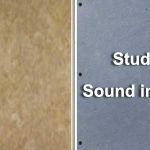In this article we will be looking at how joists are attached to walls. This is usually done during the building process. However, it is sometimes necessary to construct a new floor or ceiling later. Therefore, we will look at both scenarios
Joists are the horizontal timbers used to construct floors and ceilings in most properties. They span open spaces between main load bearing walls, beams, and other load bearing structures. Once in place they support the ceiling below and the floor above.
The most common types of joists are solid timber, although there are manufactured wooden joists (often known as I joists) and concrete and metal systems. However, in most properties you will find solid timber joists.
There are two main ways to attach joists. The first is to install them during the building process, by housing them into the internal leaf of brick, or blockwork. Here the joists are sat on the masonry as the wall reaches the ceiling level.
The second way is to attach your joists using a wall plate and hangers. This will require you to attach a timber plate around the perimeter of a room. The wall plate will need bolting in place, to make sure it is completely secure and able to take the weight of the floor/ceiling.
Joists sat on solid masonry walls
During construction, joists are often built into the internal skin of a cavity wall, when it reaches the correct level. At this point, the joists are sat directly on top of the course of masonry. Following this, the brickwork, or blockwork is built around them, which secures the joists in place and offers a very strong base for them to sit on (the load bearing wall).
The joists will usually be spaced at 400mm centres. This will make it easier to fix plasterboard, forming the ceiling below. The first joist will usually be left 50mm away from any wall it runs parallel with. This will allow any services to be easily run up the side between the timber and masonry.
The joists may also be tied together with noggins, to stop them from twisting and moving. Once the joists have been spaced correctly and secured in place, the bricklayers can continue to build the wall up and around them. There should be a mortar joint all the way around the joist. This will need to be struck or recessed, to allow for a bead of silicone between the masonry and timber.
Attaching joists using a wall plate and hangers
Another common method of hanging joists is via a wall plate and hangers. This is often done during the original construction process. However, it can also be used to fix joists to existing walls.
The wall plate will usually be the same size timber as the joists themselves. This size will vary throughout different properties. It will be determined by an engineer, who will specify the size of joist based on several factors. These include the span and load that the floor will need to support.
According to NHBC Standards for joists, the thickness of timber can be between 38mm and 89mm. Whereas the depth can range between 97mm and 235mm.
Fitting your wall plate and joists
Your wall plate should be cut to size, and you will need to fix all your joist hangers at 400mm centres. This should be done before attaching your wall plate to the wall. Generally, you should allow 50mm between the first joist and any parallel wall to allow for services. You should also make sure your second joist has a 400mm centre from the wall. This will ensure plasterboards will land on joists without cutting.
Your joist hangers will fold over the timber wall plate and be fixed in place with 30mm twist nails.
Once all the hangers are fixed in place, you can attach the wall plate to the solid wall using rawlbolts. These should be spaced every 400mm and are recommended between joists. This will make them easier to install.
Once your wall plate is in place you can start adding your joists. The joists should be cut tight into the hangers. Building regs suggest leaving no more than 6mm between the end of the joist and the wall plate. You will also need to notch out the bottom of the hanger. This will make sure the bottom of the joists are completely level for the ceiling.
Once your joists are in place, they will need securing with either nails or screws. Most joist hangers will have holes either side to allow fixings through the joist into the wall plate. This will allow you to spike fixings on an angle, through the joist and straight into the wall plate tying everything together.
Attaching joists to beams
If you have a span across a wider area with no internal partition walls, you may use a beam to add structural stability. In this case you will need to fix your joists into the beam.
Commonly you will use something like an RSJ. This is quite convenient, as it has a recess that the timber joist can sit in. However, you will need to notch the bottom and top of the joist to fit into the RSJ. These notches will need to be accurate, to ensure the floor and ceiling is completely straight and level.
Once all your joists are housed in the RSJ, you will need to add noggins to hold them in place. Again, you will need to make sure they are spaced correctly, at 400mm centres. This will ensure your plasterboards are able to fit with as few cuts as possible.
Conclusion
There are several ways to attach joists to a wall. The way you do it will depend on several factors, including when the work is carried out. If you are building from scratch, then you have the option of housing your joists straight into the masonry.
However, if you are adding joists to an existing structure, a wall plate and joist hangers is usually your best option.
Whichever method you choose, make sure you are complying with building regulations. This will ensure that your joists are safe and up to the required building standards




